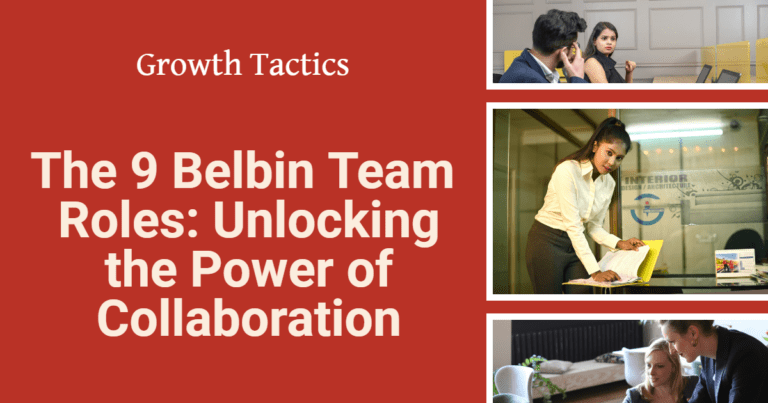Hey there! Are you ready to dive into the world of team dynamics and discover how to build a powerhouse team? Well, you’ve come to the right place. In this blog post, we’ll explore the concept of team roles and introduce you to the famous Belbin Team Roles. So, grab a cup of coffee, sit back, and let’s get started!
Jump To Section
Unveiling the Power of Team Roles
Have you ever wondered why some teams seem to effortlessly achieve their goals while others struggle to get anything done? The secret lies in understanding the unique strengths and weaknesses of each team member and leveraging them to create a harmonious and high-performing team.

Demystifying the Belbin Team Roles
Picture this: You’re building a team for an important project, and you want to ensure that each member brings something valuable to the table. Enter the Belbin Team Roles, a model developed by Dr. Meredith Belbin in the 1970s. This model categorizes team members into nine distinct roles, each with their own set of strengths and weaknesses.
The Leader: Guiding the Way
Welcome to the role of the Leader! As a capable player in a team, this role involves setting the tone and vision and charting the course that the team should take. You need to visualize the big picture and inspire the team to be excited about it. With your experience and expertise, you inspire confidence in your fellow team members, enabling them to achieve their best. You are truly the anchor that keeps the team together.
As a Leader, you must also be ready to make tough decisions. You are responsible for the success of the team, and sometimes unpopular choices must be made. You need to weigh the pros and cons and decide the course that needs to be taken. When the team is facing difficult situations, you’re the one to lean on for guidance and stability.
Your leadership skills will be crucial to the success of the team. Your ability to communicate effectively and motivate team members will be essential in keeping everyone focused and committed to achieving the goals and objectives. Your vision and insight will provide the direction the team needs to stay on course.
As an experienced and authoritative Leader, you possess the expertise to make informed decisions and the trustworthiness to build and maintain strong relationships. You set the example and inspire others to follow, instilling a sense of confidence and pride in the team.

The Team Worker: The Glue that Holds the Team Together
Ah, the Team Worker, the diplomat of the team, the master of building relationships and fostering collaboration. This role is like the glue that holds the team together, ensuring that everyone functions as a well-oiled machine. The Team Worker is like that friendly colleague who always knows how to diffuse a tense situation and bring everyone back to a harmonious state.
When it comes to communication, the Team Worker is the go-to person. They have the incredible ability to make sure that information flows smoothly among team members. No matter how heated things get, they’re there to facilitate respectful discussions and find solutions that satisfy everyone. They are excellent listeners and can empathize with various perspectives, making sure that every team member feels heard and valued.
Conflict resolution? No problem for the Team Worker. When tensions arise, they step in with their outstanding people skills and knack for finding common ground. They have a way of defusing conflicts and turning them into opportunities for growth and learning. With their calm and diplomatic approach, they are the ones who can bring out the best in people and inspire collaboration.
The Resource Investigator: The Connector and Explorer
Now, let’s talk about the Resource Investigator, the team’s very own networking guru. Picture them as an explorer, always on the lookout for new opportunities, connections, and ideas. They have an insatiable curiosity that fuels their desire to bring fresh perspectives to the team.
The Resource Investigator has an incredible talent for building and nurturing external relationships. They’re the ones who excel at networking events, effortlessly striking up conversations and forging connections that could benefit the team. They have a natural charm and charisma that draws people to them, making it easier to collaborate with external partners or stakeholders.
With their inquisitive nature, the Resource Investigator is always exploring new possibilities. They have a knack for spotting opportunities and bringing them back to the team for consideration. Their ability to think outside the box and bring in new ideas injects creativity and innovation into the team’s endeavors.
The Shaper: The Driver of Achievement
Imagine a team without a Shaper—the one who fearlessly takes charge, sets goals and drives the team towards success. It just wouldn’t be the same. The Shaper is like the engine, propelling the team forward with their determination and unwavering focus on achieving results.
When faced with challenges and high-pressure situations, the Shaper thrives. They have an innate ability to maintain composure and make tough decisions, even in the most intense moments. They see challenges as opportunities for growth and are not afraid to take risks or challenge the status quo. With their boldness and tenacity, they inspire the team to push beyond their limits and reach new heights.
The Shaper is the one who sets ambitious goals and keeps the team on track. They have an uncanny ability to rally everyone around a shared vision, ensuring that everyone is aligned and working towards a common objective. Their energy and drive are infectious, motivating team members to give their best and exceed expectations.
In a nutshell, the Team Worker builds relationships and fosters collaboration, the Resource Investigator explores new opportunities and connections, and the Shaper fearlessly drives the team toward achievement. Combine these three roles, and you have a winning recipe for success!
The Implementer: Turning Plans into Action
Ah, the Implementer, the hardworking doer of the team. They are the ones who take those amazing plans and transform them into concrete actions. With their keen eye for detail, they make sure that every i is dotted and every t is crossed. They’re like the magicians who make things happen behind the scenes.
When the team has a well-thought-out plan, it’s the Implementer who steps up to the plate. They have a knack for breaking down complex projects into manageable tasks and organizing them in a logical order. No detail is too small for them. They consider every aspect and ensure that nothing is overlooked.
Efficiency is the Implementer’s middle name. They know how to get things done with precision and speed. They excel at managing resources, allocating time effectively, and handling any unexpected hurdles that may arise. They’re the ones who make sure that deadlines are met and that the team stays on track.

The Completer/Finisher: The Perfectionist
Now, let’s talk about the Completer/Finisher, the one who brings meticulous attention to detail to the team. They are like the guardians of quality, making sure that no stone is left unturned. If there’s a typo or a discrepancy, you can bet they’ll find it.
The Completer/Finisher has an uncanny ability to spot errors and inconsistencies. They double-check everything with meticulous care, leaving no room for mistakes. They’re perfectionists, driven to deliver flawless outputs that the team can be proud of.
Their dedication to quality does not end at the final product. The Completer/Finisher is also concerned with the overall process. They ensure that the team follows best practices, adheres to established standards, and continuously improves their work. By setting high standards for themselves and others, they encourage a culture of excellence within the team.
The Coordinator: The Master of Organization
Imagine a team without a Coordinator—the master of organization. It would be like an orchestra without a conductor. The Coordinator is the one who keeps everything running smoothly, ensuring that everyone is working together harmoniously.
They have a natural talent for delegating tasks and matching the right people to the right responsibilities. With their exceptional organizational skills, they know how to create a well-coordinated team effort. They consider everyone’s strengths and expertise, maximizing efficiency and productivity.
But it’s not just about delegating tasks; the Coordinator is also a wizard at managing resources. They keep a watchful eye on timelines, budgets, and any other constraints that may affect the team’s progress. Their ability to foresee potential roadblocks and mitigate risks is invaluable in keeping the team on track.
In a team, the Implementer turns plans into action, the Completer/Finisher ensures quality and attention to detail, and the Coordinator orchestrates the team’s efforts. When these roles come together, magic happens. So, embrace the strengths that each role brings and create a harmonious symphony of success!
The Plant: The Creativity Incarnate
Now, let’s embrace the creative genius of the team: The Plant! Their imagination is a force to be reckoned with, always pushing the boundaries of what’s possible. They bring that vibrant and unique flair that takes the team’s ideas to new heights.
The Plant is like a walking goldmine of fresh ideas. Their creativity knows no bounds! They have this incredible ability to think outside the box and see things from a unique perspective. This adds a valuable touch of ingenuity to the team’s projects, making them stand out in a crowd.
The Plant has this remarkable ability to see beyond the ordinary. They challenge the norms, break free from conventional thinking, and explore uncharted territories of innovation. Their contributions inject a breath of fresh air into the team’s work, sparking the imagination of everyone around them.
The Monitor Evaluator: The Critical Thinker
Last but certainly not least, let’s talk about the Monitor Evaluator, the voice of reason in the team. They have this incredible talent for analyzing and evaluating ideas objectively, keeping the team on the right track.
The Monitor Evaluator is the team’s critical thinker, bringing clarity to every decision. They have a keen eye for detail and a knack for seeing the bigger picture. Their objective analysis helps the team identify strengths, weaknesses, opportunities, and threats, ultimately leading to well-informed decisions.
When faced with tough choices, the Monitor Evaluator is the flashlight in the dark, guiding the team towards the best possible outcome. They provide valuable insights and thoughtful perspectives that help the team avoid pitfalls and make smarter choices.
Leveraging the 9 Belbin Team Roles for Success
Congratulations! You’re now equipped with the knowledge of the nine Belbin Team Roles. But how do you use this to optimize and improve your team’s performance? Don’t worry, we’ve got you covered. Here are a few key takeaways to help you leverage the Belbin Team Roles for success:
Embrace Diversity
Remember, each team member brings unique strengths to the table. It’s important to embrace this diversity and create a balanced team that covers all necessary roles. This ensures that all aspects of the project are covered and that your team can tackle challenges from different perspectives.
Capitalize on Strengths
Encourage team members to play to their strengths and leverage their natural talents. When team members are working in roles they excel in, they will not only perform better but also feel more confident in their ability to contribute effectively. This will ultimately enhance overall team performance.
Address Weaknesses
It’s important to recognize that no one is perfect, and each team member will have weaknesses. By acknowledging these weaknesses, you can work together to overcome challenges and support each other’s growth. By addressing weaknesses, you can improve on individual performances and, in turn, help your team to deliver better results.
Foster Open Communication
Effective communication is crucial for the success of any team. Encourage an open and inclusive environment where team members can freely express their ideas and concerns. Feedback can be used to identify weaknesses and highlight areas of improvement, ensuring that your team is always growing and performing at its best.
Regularly assess team dynamics
As teams evolve and projects progress, it’s important to regularly assess how each team member is performing in their respective roles. This will help you identify any gaps or areas for improvement and address them early on. Keeping an eye on team dynamics can also help you to ensure that everyone is working together effectively.
In Summary
- Team roles are crucial for understanding and optimizing team dynamics.
- The Belbin Team Roles model categorizes team members into nine distinct roles, each with its own strengths and weaknesses.
- Leveraging the Belbin Team Roles can help create a balanced and high-performing team.
- Embrace diversity, capitalize on strengths, address weaknesses, foster open communication, and regularly assess team dynamics to unlock the full potential of your team.
Remember, building a great team takes time and effort, but the rewards are worth it. So, go ahead, apply the principles of the Belbin Team Roles, and watch your team soar to new heights. Happy collaborating!


